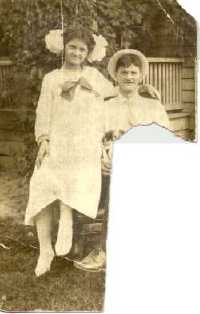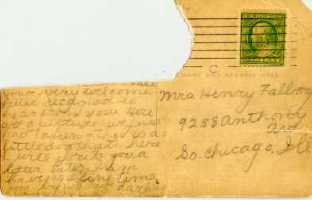Sign up for the Family Tree Newsletter Plus, you’ll receive our 10 Essential Genealogy Research Forms PDF as a special thank you!
Get Your Free Genealogy Forms
"*" indicates required fields
 |
 |
When our relatives had a paper photograph taken, they usually had their choice of formats. In Paula Wolek’s case, her family chose to use a postcard for their portrait. This was less expensive than mounting the image on heavier card stock and it enabled the picture to be sent by mail. In this case, Mrs. Henry Falberg of 9258 Anthony Ave., Chicago, IL, received this picture of a man and young girl. A large piece of the postcard is missing, but the message fills in the lost part of the image.
There are many clues in this picture and on the postcard. First there is the striking resemblance between the two people in the picture. It is easy to imagine that this is a father and daughter, but the message in pencil on the back of the card reads as follows: “your very welcome letter recd glad to hear from you. Here is our picture we just had taken & this is a little dog that’s here. I will write you a letter later. I am having a fine time Good by I—– darling neice —–.” The dashes refer to illegible words. The name of the sender is no longer legible because the pencil smeared through handling. Only the dog’s ears are barely visible near the tear in the picture. Unlike most unidentified photographs, this image and its message tells the owner something about the family. The relationship between the two people in the picture is unclear. Nothing is known about why Mrs. Henry Falberg received this postcard portrait.
The girl’s dress is a sailor style from before World War I with her hair in large ribbons on either side of her head. Her uncle’s clothing is from the same period. It is obviously summertime because the foliage in the background is in full bloom. But this time the date for the image isn’t based on the clothing.
The stamp used to mail the card provides a time frame for the picture. The US Postal Service issued this Franklin 1-cent stamp between 1908 and 1913. A stamp collector could probably narrow down this date further by examining the original for perforation marks and watermarks that don’t appear in a scan of the stamp.
Now that the owner has a span of dates for the image, she can begin to piece together the family data using census records and city directories to find additional details about Mrs. Henry Fahlberg. By using genealogical resources to learn more about the recipient it might be possible to assign names to the two individuals in the picture.
The missing piece of the image could contain other bits of identifying information such as a postmark, the names of the individuals in the picture and even a specific date for the picture. It is obvious that rough handling damaged this photograph. So how can Paula protect this image from further harm? Very simply. With acid- and lignin-free card stock and a polypropylene or mylar sleeve, she can reinforce the thin picture and prevent any further damage. A list of additional tips and suppliers appears in my new book, Preserving Your Family Photographs (Betterway, $19.99).
Find out how to submit your own picture for possible analysis by Maureen Taylor. E-mail her at mtaylor@taylorandstrong.com.
ADVERTISEMENT

